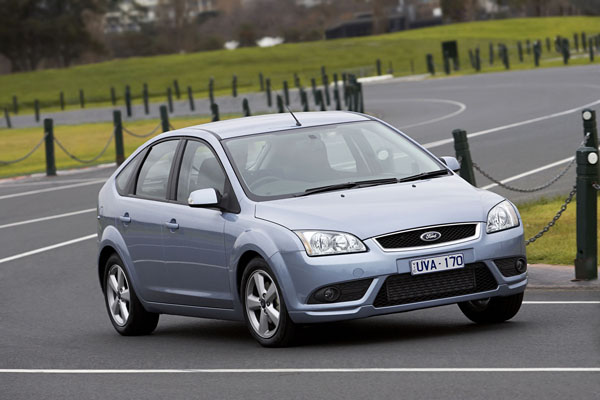Ford Focus is a small-medium Euro model that offers better than average ride and handling, that’s even in the standard model which have attracted quite a few keen drivers. Even better, Focus comes in an impressively large number of sports variants.
Ride comfort is pretty good in the standard cars, however they can be on the harsh side on rough roads. By contrast sports models may be on the firm side for those looking for comfort ahead of handling. Showing its Euro heritage, Focus is very good at high speed on motorways.
We are examining models from the second generation that was launched here in May 2005. It was facelifted in June 2007 and a big emphasis was put on the fitment of safety features. Focus gen-three arrived in November 2011 and had a working over with some extra gear in September 2015. An all-new model is anticipated in 2019.
Focus is sold with three or five-door hatchback bodies and as a four-door sedan. From September 2007 until mid-2010 a coupe-cabriolet body with a folding hardtop was imported. The open-top Focus was expensive and didn’t sell well, but it’s well worth a look if you want something out of the ordinary.
Engines in the standard Focus range are four-cylinder petrol and from July 2007 a four-cylinder turbo-diesel. A five-cylinder turbo-petrol was used on the hot XR5.
Most Focus models prior to 2011 come with a five-speed manual gearbox. Six-speed manual gearboxes are fitted to the sporty Focus ST 170, the RS and turbo-diesel engines. From November 2011 the new Focus received a six-speed manual. The six-speed has a much nicer feel in its change action to the slightly sloppy five.
The new Focus model from May 2005 had manual overrides on its four-speed automatic transmission. From 2011 a dual-clutch six-speed auto was used. This auto had problems (see our What To Look For section). The dual-clutch was replaced by a six-speed conventional torque convertor auto in September 2015 as part of a major makeover of the complete range.
Focus models with a focus on sport are sold in a variety of models some relatively mild, others playing on the wild side; Focus Zetec, SR, Sport, ST170, XR5 and the full-house Focus RS.
Ford is strongly represented in Australian country areas reflecting, in particular, the love of Falcons by buyers in the bush. Dealers in remoter areas may not have spares for the Focus in stock, but can usually get them shipped in within a few working days.
Most routine service work can be done by a competent amateur. Please don’t tackle any safety related items yourself, though. A workshop manual is a smart investment.
With the exception of the hot Ford Focus XR5 and RS insurance charges are usually moderate.
WHAT TO LOOK FOR
Check the dual-clutch PowerShift automatic transmission isn’t harsh in its changes or slips out of gear. Ford Australia has been fined by the Australian Federal Court over its handling of owner complaints. You can check with a Ford dealer or contact Ford Australia on 1800 503 672 to enquire about this.
Build quality of the Ford Focus is generally good (from 2005 most were built in South Africa), though generally not up to Japanese or Korean quality standards.
Make sure the electrical systems are okay by turning everything on and off. Using the owner’s manual gives you a list of all the things that should happen while you’re doing this.
Look over the cabin and boot for signs of wear and tear.
Shuddering under braking may indicate warped brake discs.
Scratches on the top of the rear bumper will often indicate that lazy owners used the bumper as support when loading and unloading the boot.
A safety recall of pre 2010 turbo-diesel cars was instigated to check the fitment of the exhaust heat shield.
HOW MUCH?
Expect to pay from $2000 to $4000 for a 2007 Ford Focus CL; $6000 to $10,000 for a 2007 Coupe-Cabriolet or a 2010 TDCi; $7000 to $11,000 for a 2012 Trend; $8000 to $12,000 for a 2011 Sport or a 2013 Trend; $10,000 to $15,000 for a 2012 Titanium; $12,000 to $17,000 for a 2014 Trend; $15,000 to $21,000 for a 2013 ST; and $19,000 to $26,000 for a 2017 Titanium.
CAR BUYING TIP
We start our check of any used car by looking at the wheels and tyres for signs of kerb damage caused by poor parking, the left front is usually the first to suffer.
